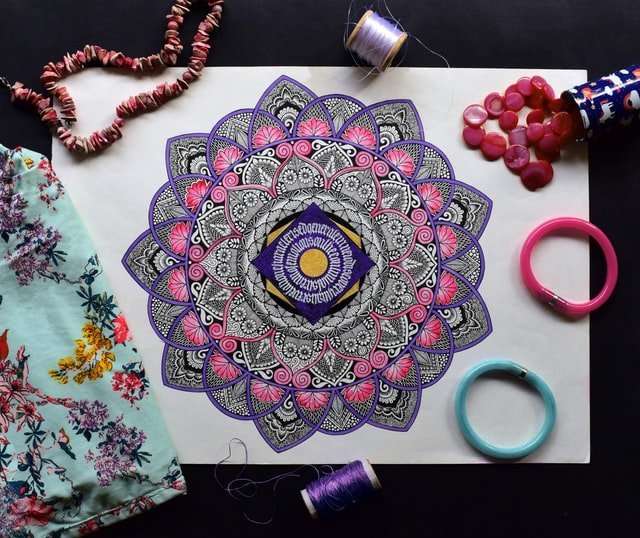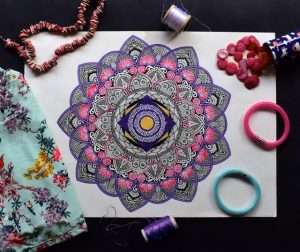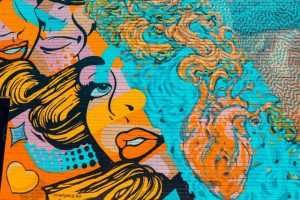If you are an aspiring mandala artist, there is one thing I would like to tell you. It’s something I wish someone had told me before I spent hours of work on my first mandala. You can avoid the frustration by learning this one simple trick.
I started my first mandala with the best of intentions. I decided that I wanted to practice drawing something more intricate than a circle. The problem is, when you’re trying to learn something new, that doesn’t mean you want to be confused by unnecessary details in your design.
I wanted to draw something simple, but not too simple, and beautiful yet not distracting. What is most important about any artwork is not the subject matter but the skill of the artist. If you are an artist, or if you want to be an artist, your goal should be to improve your skill, not prove how good you already are at drawing things.
You can finish your first mandala using my secret trick: Don’t worry about drawing details for awhile; just concentrate on making a beautiful abstract design with nothing but circles and dots; then use your circles and dots as guides for drawing in the details later on when you feel ready for them.
We do not draw the best circles with a compass, but by eye. It is all about taking your time and making sure you are seeing the whole circle, not just the center of it.
You have to take your time on your first drawing. You have to see each part of it as if you’ve never seen anything like it before. Look at the center for a few minutes. Look at the borders for a few minutes. Then look at the center again.
Allowing yourself plenty of time to absorb what you are looking at is very important with mandalas, because there is so much detail in them, and it can be tempting (especially for beginners) to rush through them and make them more abstract than they need to be. A great photo might take an hour or more of work before it’s finished, but that’s because it’s really good; many people would be happy with their shot after five minutes. Be patient with yourself (it will pay off).
Mandala art designs are beautiful and abstract. They can be drawn with both written words and pictures. You can choose the color scheme of the mandala to reflect your own tastes, while still making it look beautiful.
You can draw a mandala with some basic drawing skills. To get started, you should have some familiarity with the way the basic shapes of circles and squares fit together.
I like to draw mandalas (my earlier post about them is here ). I especially like to make the ones with intricate symmetrical patterns. It’s a neat exercise in balance and design.
I think it’s also a good exercise in learning to draw in a way that helps you to see what you’re drawing, and in learning to trust your own judgment about how much detail is enough and what the shapes really look like.
When I started drawing mandalas, I tried drawing them in black and white, which is the traditional approach. But that felt too limiting – after all, they’re colorful things! So I tried drawing them in color. That was fun, but for some reason it made me feel like I had less control over the outcome – it was easier to produce something garish than something elegant. Also, the colors were so bright that they made it harder to see certain details of the pattern, by making them blend into each other or wash out.
So I’ve settled on drawing my mandalas in pencil first – then filling them with colored pencils or watercolors or whatever effect I want afterwards.
I want to try something new with this mandala. I’m looking forward to the challenge of creating something with a lot of different elements. It’s exciting.
I’m not exactly sure what it will be yet. I’d like it to be an organic shape with flowing lines and curves, but I’ve never done anything like that before. So there’s a part of me that feels like I should go smaller, something with only two or three layers instead of nine or ten.
But I’m going to try not to do that. Like I said, it’s exciting, and if I hold back now, when will I ever get to do this? Even if this one doesn’t turn out well (and it might not), I’ll learn from the experience.
I’ve never tried drawing anything organic before, so this is uncharted territory for me. If you have any tips for drawing organic shapes, let me know in the comments!
Mandala is a Sanskrit word that means “circle.” The mandala is an ancient Buddhist visual representation of the universe. It consists of geometric designs that provide a sense of balance, harmony and order with the use of repetitive symbols.
The mandala is used in meditation to assist in concentration and to direct attention away from external distractions which hinder the process of enlightenment.
There are different types of mandalas, including sand paintings, thangkas, which are Tibetan paintings on silk or cotton, and mandala art. The word thangka comes from the Tibetan word for “to complete.”
To create a beautiful mandala art design, you’ll need several pieces of colored paper or card stock. You can also use fabric or canvas if you prefer to paint on it instead of drawing with crayons or markers. You can either buy premade coloring sheets for this purpose (they’re available at most craft stores) or choose your own colors for your mandala design.
The first step is to sit down with all your materials and relax for a few minutes. Focus on your breathing; don’t force it but try to make it even and slow.
We have a tendency to think of the beauty of a mandala as secondary to its meaning. But on a very basic level, a mandala is a work of art, and as such it should be beautiful.
The more abstract the mandala, the easier it is to see its symbolic meaning, but the harder it can be to see its visual beauty. In an abstract mandala, every line and shape should have some symbolic meaning. In a figurative or representational mandala, those meanings can be implicit rather than explicit.



